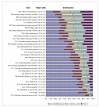"Coercion Experience Scale" (CES)--validation of a questionnaire on coercive measures
- PMID: 20074355
- PMCID: PMC2837616
- DOI: 10.1186/1471-244X-10-5
"Coercion Experience Scale" (CES)--validation of a questionnaire on coercive measures
Abstract
Background: Although the authors of a Cochrane Review on seclusion and mechanical restraint concluded that "there is a surprising and shocking lack of published trials" on coercive interventions in psychiatry, there are only few instruments that can be applied in trials. Furthermore, as main outcome variable safety, psychopathological symptoms, and duration of an intervention cannot meet the demand to indicate subjective suffering and impact relevant to posttraumatic stress syndromes. An instrument used in controlled trials should assess the patients' subjective experiences, needs to be applicable to more than one intervention in order to compare different coercive measures and has to account for the specific psychiatric context.
Methods: The primary version of the questionnaire comprised 44 items, nine items on restrictions to human rights, developed on a clinical basis, and 35 items on stressors, derived from patients' comments during the pilot phase of the study. An exploratory factor analysis (EFA) using principal axis factoring (PAF) was carried out. The resulting factors were orthogonally rotated via VARIMAX procedure. Items with factor loadings less than .50 were eliminated. The reliability of the subscales was assessed by calculating Cronbach.
Results: Data of 102 patients was analysed. The analysis yielded six factors which were entitled "Humiliation", "Physical adverse effects", "Separation", "Negative environment", "Fear" and "Coercion". These six factors explained 54.5% of the total variance. Cronbach alpha ranged from .67 to .93, which can be interpreted as a high internal consistency. Convergent and discriminant validity yielded both highly significant results (r = .79, p < .001, resp. r = .38, p < .001).
Conclusions: The "Coercion Experience Scale" is an instrument to measure the psychological impact during psychiatric coercive interventions. Its psychometric properties showed satisfying reliability and validity. For purposes of research it can be used to compare different coercive interventions. In clinical practice it can be used as a screening instrument for patients who need support after coercive interventions to prevent consequences from traumatic experiences. Further research is needed to identify possible diagnostic, therapeutic or prognostic implications of the total score and the different subscales.
Trial registration: Current Controlled Trials ISRCTN70589121.
Figures
Similar articles
-
Antipsychotic treatment of psychotic disorders in forensic psychiatry: Patients' perception of coercion and its predictors.Int J Law Psychiatry. 2018 Mar-Apr;57:113-121. doi: 10.1016/j.ijlp.2018.02.004. Epub 2018 Mar 2. Int J Law Psychiatry. 2018. PMID: 29548498
-
[Validation of the QFS measuring the frequency and satisfaction in social behaviours in psychiatric adult population].Encephale. 2006 Jan-Feb;32(1 Pt 1):45-59. doi: 10.1016/s0013-7006(06)76136-x. Encephale. 2006. PMID: 16633290 French.
-
Validation of a short version of the Coercion Experience Scale (CES-18): Psychometric characteristics in a Spanish sample.Psychiatry Res. 2019 Feb;272:284-289. doi: 10.1016/j.psychres.2018.12.126. Epub 2018 Dec 25. Psychiatry Res. 2019. PMID: 30594761
-
[Caregiver burden in relatives of persons with schizophrenia: an overview of measure instruments].Encephale. 2003 Mar-Apr;29(2):137-47. Encephale. 2003. PMID: 14567165 Review. French.
-
Variables Associated With the Subjective Experience of Coercive Measures in Psychiatric Inpatients: A Systematic Review.Can J Psychiatry. 2018 Feb;63(2):129-144. doi: 10.1177/0706743717738491. Epub 2017 Oct 25. Can J Psychiatry. 2018. PMID: 29069981 Free PMC article.
Cited by
-
Effect of standardized post-coercion review on subjective coercion: Results of a randomized-controlled trial.Eur Psychiatry. 2021 Dec 7;64(1):e78. doi: 10.1192/j.eurpsy.2021.2256. Eur Psychiatry. 2021. PMID: 34872630 Free PMC article. Clinical Trial.
-
Subjective experience of coercion in psychiatric care: a study comparing the attitudes of patients and healthy volunteers towards coercive methods and their justification.Eur Arch Psychiatry Clin Neurosci. 2016 Jun;266(4):337-47. doi: 10.1007/s00406-015-0598-9. Epub 2015 Apr 22. Eur Arch Psychiatry Clin Neurosci. 2016. PMID: 25900468
-
Satisfaction and Perceived Coercion in Voluntary Hospitalisations: Impact of Past Coercive Experiences.Psychiatr Q. 2022 Dec;93(4):971-984. doi: 10.1007/s11126-022-10005-8. Epub 2022 Oct 24. Psychiatr Q. 2022. PMID: 36279029 Free PMC article.
-
Who is Subjected to Coercive Measures as a Psychiatric Inpatient? A Multi-Level Analysis.Clin Pract Epidemiol Ment Health. 2013 Jul 12;9:110-9. doi: 10.2174/1745017901309010110. eCollection 2013. Clin Pract Epidemiol Ment Health. 2013. PMID: 23986786 Free PMC article.
-
Impact of the 'reserved therapeutic space' nursing intervention on patient health outcomes: An intervention study in acute mental health units.Nurs Open. 2023 Aug;10(8):5749-5757. doi: 10.1002/nop2.1750. Epub 2023 Apr 21. Nurs Open. 2023. PMID: 37084278 Free PMC article.
References
-
- Tunde-Ayinmode M, Little J. Use of seclusion in a psychiatric acute inpatient unit. Australasian Psychiatry. 2004;12:347–351. - PubMed
-
- Fisher WA. Restraint and seclusion: a review of the literature. American Journal of Psychiatry. 1994;151:1585–1591. - PubMed
-
- Sebit MB, Siziya S, Acudo SW, Mhondoro E. Use of seclusion and restraint in psychiatric patients in Harare Hospital Psychiatric Unit, Zimbabwe: gender differences. Central African Journal of Medicine. 1998;44:277–280. - PubMed
Publication types
MeSH terms
Associated data
LinkOut - more resources
Full Text Sources
Medical



